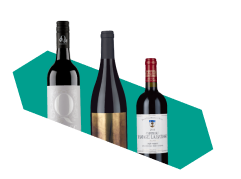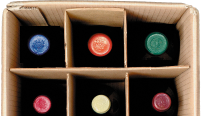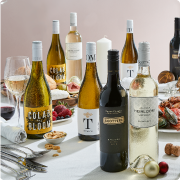Shiraz is one of the world’s favourite red wines. Although it has its roots in Rhône, France, it’s now best associated with Australia, where it is the country’s most planted red grape variety. Its adaptability to various climates and growing conditions has made it a staple in the Australian wine industry, and the bold, full-bodied and fruit-forward style of Australian Shiraz is loved by wine enthusiasts both at home and abroad.
In this guide, we’ll explore tasting notes, food pairings, serving suggestions and top-rated Shiraz wines.
What is Shiraz?
Shiraz, pronounced ‘shuh-razz’, is a dark-skinned grape variety famous for producing robust, full-bodied red wines packed with jammy flavours and pepper notes. The Shiraz grape, known as Syrah in France and the rest of Europe, originated in France’s Rhône Valley but found a new expression and global popularity in Australian Shiraz.
Shiraz grapes thrive in various Australian regions. The Barossa Valley is famous for producing powerful, intensely fruity Shiraz wines, while cooler climate regions such as the Yarra Valley and Adelaide Hills produces more structured, elegant and fragrant styles. Other notable Shiraz-producing regions include McLaren Vale, Langhorne Creek, Clare Valley, Margaret River and Hunter Valley.
Despite its French roots, Shiraz has become an Australian speciality, contributing significantly to the country’s wine reputation and popularity on the global stage. Australia is home to the world’s oldest continuously productive Shiraz vines, some of which are up to 180 years old.
In addition to still wines, Australian winemakers use Shiraz to create lively sparkling reds.
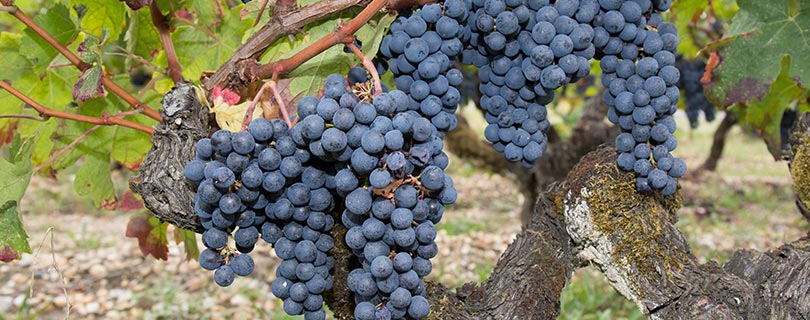
Shiraz vs Syrah – what’s the difference?
Syrah and Shiraz are the same grape variety, but regional differences (such as climate and soil), winemaking methods and even local wine regulations all influence the wines’ characteristics.
Syrah wines from France are typically more restrained and elegant. They often exhibit black fruit, pepper and mineral flavours, particularly when the grapes are grown in the variety’s native Rhône Valley. Syrah wines can also be found in Italy, Argentina, Chile and New Zealand.
Australian Shiraz is usually bolder and fruit-forward, often with ripe blackberry flavours and chocolatey richness, especially when the grapes are grown in warm regions such as the Barossa Valley.
Is Shiraz a red wine?
Shiraz is a red wine known for its deep, inky colour, which can also have a tinge of purple. It’s intense, robust and full-bodied, with jammy fruit notes and hints of earthiness.
Shiraz is also a key player in one of the world’s most popular red blends – GSM. When combined with Grenache and Mataro (also known as Mourvèdre), Shiraz adds a robust structure, intensity, dark fruitiness and deep colour.
Thanks to their versatility, Shiraz grapes are also used to produce rosé wines, which balance the grape’s vibrant fruitiness with a refreshing, light style. These wines achieve their colour from limited skin contact with the Shiraz grape skins.
Is Shiraz wine dry or sweet?
Shiraz is typically a dry wine – this is the most common and popular style. A wine is considered ‘dry’ when most of the natural grape sugars are converted into alcohol during fermentation, leaving minimal residual sugar.
However, the Shiraz grape can be used to create sweet wines, such as the premium fortified wines from Australia’s Rutherglen region. Adding a grape spirit (typically brandy) halts the fermentation process, leaving high residual sugar levels.
Refreshing, fruit-forward Shiraz rosé is typically made in the drier style. However, both sparkling and rosé Shiraz wines can range from dry to sweet.
What does Shiraz wine taste like?
Shiraz is known for its full-bodied style, robust tannins and deep, complex flavours. Although specific flavours and aromas can vary depending on where in the world the wine has been made, Shiraz has a number of core flavours and aromas typical of the variety. These include:
Red and blackberries
Black orchard fruits
Hints of chocolate
Dried herbs and spices
Shiraz wines from warmer climates often display jammy, ripe blackberry, plum and cherry flavours. The wine may also have notes of clove, cinnamon or other baking spices, along with green olives and mint.
Shiraz’s flavours are less jammy when grown in cooler climates. They lean more towards red fruits like raspberry and tart red cherry, with hints of cracked black pepper, violet and gravel.
If Shiraz wines are aged in oak, they can develop sweeter notes of vanilla, coconut, chocolate, smoke or sweet tobacco.
Where is Shiraz grown?
Shiraz thrives in a number of countries around the world. Each region has its own unique spin on the variety depending on winemaker preferences, regional winemaking traditions and the combination of climate, soil and topography. Some of the key Shiraz regions include:
The Barossa Valley, Australia – This is Australia’s flagship region for Shiraz. Barossa Valley is home to bold, full-bodied reds with jammy, ripe black fruit flavours and a warming chocolatey richness. The best examples can age for many years, developing complex spice, leather and earth notes.
McLaren Vale, Australia – A South Australian region known for its premium Shiraz wines that have distinct ripe blackberry flavours. McLaren Vale wines often have a chocolate note and velvety texture, with some having occasional hints of fresh eucalyptus or mint.
The Hunter Valley, Australia – Hunter Valley winemakers produce medium-bodied Shiraz wines with earthy, spicy notes complemented by juicy dark berry flavours. The wine often has a savoury character, setting it apart from the more fruit-forward styles found elsewhere in the country.
The Rhône Valley, France – Winemakers in the north of the Rhône Valley produce dark, full-bodied Syrah/Shiraz with flavours of black fruit, violets and black pepper. The Southern Rhône is known for its premium red blends, and Syrah is often used to add structure and dark fruit flavours.
Hawke’s Bay, New Zealand – Hawke’s Bay Syrah is often compared to northern Rhône wines thanks to its medium-bodied style and flavours of black cherries, black pepper and violets.
Regions like California, USA, and Stellenbosch, South Africa, also create excellent Shiraz/Syrah wines. These wines range from the ripe, lush Californian styles to the spicier, more structured wines made in Stellenbosch.
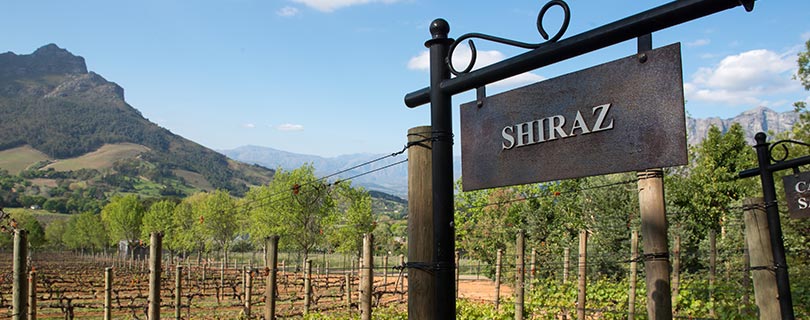
Shiraz vs Merlot vs Pinot Noir
Shiraz, Merlot and Pinot Noir are some of the most popular red wines in the world. Although they all originate from France, they are now grown worldwide, and each one offers something different to red wine lovers.
Shiraz/Syrah
Origins and growing regions – Originally from the Rhône Valley, Shiraz thrives in various wine regions worldwide, particularly in Australia.
Grape characteristics – Shiraz grapes are typically small and dark-skinned, known for their ability to adapt to a range of climates.
Flavours – Depending on the climate, Shiraz’s flavours range from blackberry, plum and black cherry to pepper, mint and chocolate in warmer regions.
Typical styles – Styles range from full-bodied, rich and ripe in warm climates like the Barossa Valley to more elegant and peppery in cooler regions like France’s Rhône Valley.
Food pairings – Shiraz can match and balance intense, rich, and savoury flavours and pairs well with hearty dishes like grilled steaks, barbecued pork and roasted root vegetables.
Merlot
Origins and growing regions – Merlot originates from Bordeaux, France. It’s grown widely worldwide in several key wine areas, including France, Italy and California.
Grape characteristics – Merlot grapes are medium-sized and have dark blue skin. They are celebrated for their ability to produce soft, medium- to full-bodied wines.
Flavours – This red has deep notes of black cherry, plum and herbs, often with cocoa, graphite and earthy undertones.
Typical styles – Merlot is lush and fruit-forward when produced in warmer regions and more structured with brighter acidity in cooler regions.
Food pairings – The wine pairs deliciously with roast chicken, braised beef or savoury mushroom risotto. Merlot wine harmonises with these dishes’ rich, savoury flavours while its soft tannins and acidity cut through fattiness.
Pinot Noir
Origins and growing regions – Pinot Noir originates from Burgundy in France. It’s a delicate grape that prefers the cooler climates found in Burgundy, Oregon, New Zealand and the cooler areas of California.
Grape characteristics – Pinot Noir grapes are small with thin skins. The grape is notoriously difficult to grow but worth the effort for its elegant, complex wines.
Flavours – Pinot Noir typically exhibits red cherry, raspberry, cranberry and strawberry flavours alongside earthy mushroom hints and occasional floral notes.
Typical styles – Pinot Noir is typically light- to medium-bodied with high acidity, soft tannins and complex layers of delicate flavours.
Food pairings – This wine’s versatility makes It suitable for a wide range of dishes, from salmon to duck and roasted vegetables. Its acidity cuts through fattier foods, while its delicate flavours don’t overpower lighter dishes.
How many calories are in a glass of Shiraz wine?
The number of calories in a glass of Shiraz can vary depending on several factors, such as alcohol content and residual sugar levels. On average, a standard 150ml glass of Shiraz, which typically has around 14% alcohol, contains approximately 120 calories.
A whole bottle of Shiraz (typically 750ml) contains roughly 600 calories. However, actual calorie counts can vary based on the specific wine.
What are the best Shiraz food pairings?
Ribeye steak
A marbled steak cut like ribeye makes an excellent partner for Shiraz. The wine’s bold fruit character, spice notes and tannic structure balance out the hearty flavours, rich fat and char from grilling.
Lamb tagine
The dark fruit flavours and spice notes in a glass of Shiraz harmonise with the complex flavours of lamb tagine, especially when spiced with cumin and ginger. This pairing allows the food and wine to shine without overpowering the other.
Barbecue pulled pork
The smoky, sweet and slightly spicy characteristics of barbecue pulled pork shine when paired with Shiraz wine’s robust, fruity, peppery notes. The wine’s acidity also cuts through the pork’s fatty richness, creating a delicious balance.
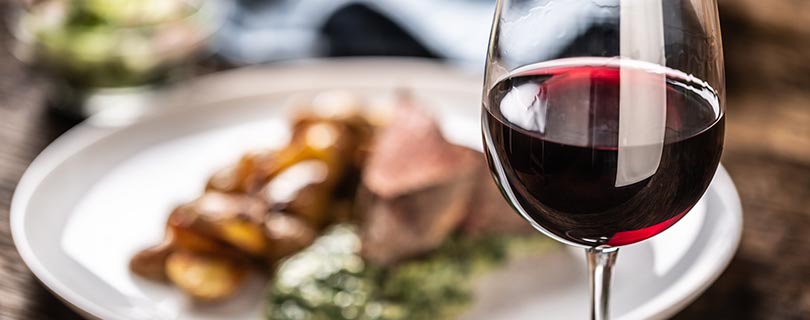
Roasted root vegetables
The body of Shiraz wine pairs well with hearty vegetables such as roast beetroot, carrots or sweet potatoes. The wine’s ripe, sweet fruit flavours complement the caramelisation from roasting these sweeter vegetables.
Dark chocolate
Shiraz’s dark fruit flavours and peppery notes can provide a wonderful contrast to the bittersweet character of dark chocolate. Experiment pairing glasses of Shiraz with mousses, moist chocolate cakes and rich ganache.
How to serve Shiraz
To fully enjoy your Shiraz, consider how you serve this robust red.
It’s common to decant many types of red wine, including Shiraz. Younger, fuller-bodied styles can certainly benefit from the process as it allows the Shiraz to ‘breathe’, leading to softer tannins in the wine. It can also help release the wine’s complex aromas and flavours.
When it comes to serving temperature, serve your Shiraz at 16-18°C. Drinking the wine too warm can make the alcohol more pronounced while serving it too cold can mute those juicy dark fruit and spice notes.
An oversized red wine glass with a large, rounded bowl is ideal for serving Shiraz. The large bowl allows just enough air into the Shiraz and directs the wine to the tip of the tongue so you can fully appreciate its flavours.
How long does Shiraz last after opening?
An opened bottle of Shiraz can last 3-5 days. To help your wine last as long as possible, re-cork the bottle tightly or use a wine stopper and store it upright in the fridge to slow down oxidation.
Unopened bottles should be stored horizontally so that the cork remains moist, preventing it from drying out and letting in air. Keep unopened wine bottles in a cool, dark place to slow the ageing process – ideally, this should be a consistent temperature of 12-15°C.
Choosing a good Shiraz
If you’re looking for... a light wine
Try – Zonte’s Footstep Chocolate Factory McLaren Vale Shiraz 2021. This Aussie Shiraz is velvety rich and plush, with a milk chocolate core and notes of dark cherries, plums, black forest cake and mocha.
If you like... full-bodied wine
Try – Patronus Reserve Barossa Shiraz 2021. Big, bold and full-bodied, this lavish Barossa Valley Shiraz is made from old-vine grapes. Its ripe aromas of smoky blackberry, fruitcake, toasty oak and dark chocolate are delicious when matched with lamb or venison.
If you like... vegan wine
Try – Tyrrel’s Blacksmith's Hut Shiraz 2023. This is a top-quality, vegan red from Heathcote, Victoria. Expect soft, savoury tannins and a crunchy acidity with bright red fruits and savoury spice notes.
If you like... oak-aged wine
Try – Blackstrap McLaren Vale Shiraz 2022. Powerful and dark, this ultra-velvety, oak-aged Shiraz showcases all the inky, chocolatey, deep black fruit richness that McLaren Vale is known for. Oak ageing adds wonderful depth and structure to the wine.


